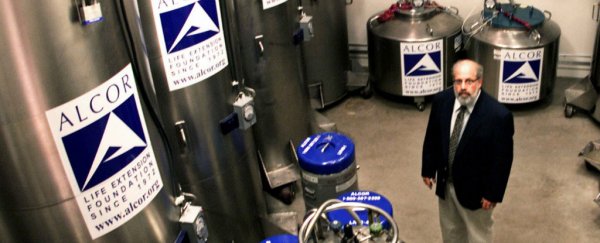A 14-year-old girl has just been granted the right to have her body cryonically frozen in the hope that she will be brought back to life one day.
The teen, from London, was dying from cancer when she took her case to the high court.
"I don't want to be buried underground. I want to live and live longer and I think that in the future they might find a cure for my cancer and wake me up," she said.
"I want to have this chance. This is my wish."
Cryonics is the practise of preserving a human body in extremely cold temperatures after they die, with the hope of being able to revive them sometime in the future when science has advanced enough.
People who undergo the procedure must be declared legally dead, as it's illegal to cryonically preserve someone who's still alive.
However, legally dead is not the same as completely dead. Legal death occurs when the heart has stopped beating, but you're technically still alive until all brain function ceases.
Cryonics works in this narrow but crucial window, to preserve that tiny amount of cell function that's still happening.
If you sign up at one facility, the Alcor Life Extension Foundation in Arizona, the protocol consists of four elements: deployment and standby, stabilisation, cryoprotectant perfusion, and cryogenic cool-down.
1. Deployment and standby
You have to be signed up with a cryonics facility before your death, so that the team can be prepared. Decomposition starts happening pretty much immediately, so the window of time for the team to start the preservation process is narrow.
They will still try though. On the Alcor website it states: "it is a general principle of cryonics that cryopreservation should proceed after legal death even under poor biological conditions when standard protocol procedures cannot be performed."
A team is notified of your death and rushes to your side once you've passed, and they stabilise your body by supplying your brain with oxygen and blood to preserve minimal function.
2. Stabilisation
After this, you are injected with heparis — an anticoagulant that prevents blood clots — and packed in ice. Your lungs might be ventilated too.
If it will take a long time to be transported to the operating room, your blood may be replaced with an organ preservation solution.
3. Cryoprotectant perfusion
The freezing begins when you reach the cryonics facility. Your body cannot simply be frozen in liquid nitrogen because it would damage your cells. You are around 70 percent water, so if it all froze, your cells would shatter.
Instead, the cryonics team starts a process called vitrification. They remove all the water from your cells and replace it with a chemical mixture of organ preservation and antifreeze chemicals called a cryoprotectant.
In theory, this protects organs and tissues from forming ice crystals and instead are put into a state of suspended animation. It's the same technique that has dramatically improved the way eggs and embryos are frozen and thawed in fertility treatments.
Vitrification has successfully been used to freeze small pieces of tissue, and scientists even managed to preserve and recover the brain of a rabbit.
However, we're probably still a long way off from being able to freeze and thaw larger structures, as vitrifying organs such as human kidneys for transplantation has not been done successfully.
4. Cryogenic cooldown
Once vitrified, your body is cooled on a bed of dry ice until it reaches -130 degrees Celsius. Then you're placed head down in a large metal tank filled with liquid nitrogen at around -196 degrees Celsius.
It costs over £100,000 (US$125,000) to get your whole body cryonically preserved, but for a smaller fee, you can choose just to freeze your brain. This relies on the idea that one day in the future, scientists will be able to grow a clone of your body and you will somehow be revived.
That's still not the end of it though
Nobody has ever been revived from being frozen, because this technology doesn't exist. It also hasn't been around enough for everyone who has been preserved to be cured from whatever illness was killing them in the first place.
That being said, medicine has come a long way in that people are often, technically, brought back from the dead. Defibrillators can shock your heart into a regular rhythm again, and in some surgeries, people are cooled down to very low temperatures so doctors can operate on aneurysms.
There's also the ethical issues to consider about whether a clone grown from your cells would really be 'you' or not. With the brain being such a complex organ, it's also impossible to know how much damage has been done by the process until you wake them up again.
The biggest problem with revival would be thawing a person the right way at the right speed. If it isn't done exactly right, your cells could turn to ice and be destroyed.
The first person to be cryonically preserved was 73-year-old James Bedford, who was frozen in 1967. He died of kidney cancer and was frozen a few hours after his death. In the cryonics community, January 12th is celebrated as 'Bedford Day'.
According to Alcor, Bedford's body is still in a good condition. It's quite possible that his metastasised cancer would be treatable now if he were revived, it's just the warming him back up again that needs to be figured out.
This article was originally published by Business Insider.
More from Business Insider:
